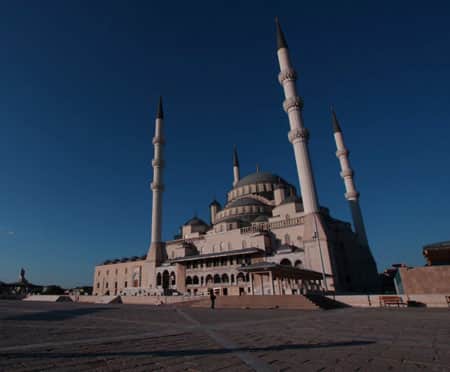Ankara – a Treasure Trove of Ancient Architecture
 A bit more humble in population and geographical stature than the luxurious city of Istanbul, Ankara is Turkey’s capital and second largest city. The city of Ankara is advantageously positioned in the centre of Turkey’s notable transportation grid and functions as marketing central for neighbouring agricultural regions. Not only is it considered a key point for active commerce supporting such items as wine, flour, leather goods and carpets, it is additionally home to the world famous Angora cat, Angora goats (mohair) and Angora rabbits (prized wool). This map of Turkey shows the region and city clearly.
A bit more humble in population and geographical stature than the luxurious city of Istanbul, Ankara is Turkey’s capital and second largest city. The city of Ankara is advantageously positioned in the centre of Turkey’s notable transportation grid and functions as marketing central for neighbouring agricultural regions. Not only is it considered a key point for active commerce supporting such items as wine, flour, leather goods and carpets, it is additionally home to the world famous Angora cat, Angora goats (mohair) and Angora rabbits (prized wool). This map of Turkey shows the region and city clearly.
The ancient city of Ankara is rich with archaeological sites given its 5000 years of history. The oldest part of the city, the citadel, dates back before the times of the Romans. Anyone sightseeing in Ankara will discover a great deal of ancient architecture and traditional Turkish accommodations along with some of the finest restaurants in the world.
Ankara is an old city with a variety of interesting archaeological sites to explore. A hill that looks over the city is topped by ancient castle ruins, which only embellishes the panoramic vista. Even though there are only a few significant ruins that have survived around the old citadel, there are several well-preserved ancient remains in other areas throughout the city.
Other archaeological sites to tour:
Temple of Augustus and Rome – Also referred to as the Monumentum Ancyranum, was built sometime between the 25 BC – 20 BC period after the establishment of the Roman province of Galatia and the Roman Empire’s overthrow of Central Anatolia.
Column of Julian – Currently in the Ulus district, the Column of Julian (or Julianus) was constructed to celebrate and pay homage to the Great Roman Emperor Julian the Apostate’s trip to Ancyra (modern day Ankara) in 362.
Roman Bath – The Roman bath was created while Emperor Caracalla reigned to honor the God of Medicine, known as Asclepius, in 3rd century AD. The bath consists of a hot room (Caldarium), warm room (Tepidarium), and a cold room (Frigidarium), which was entered after the Caldarium and Tepidarium to open the pores of the skin. It is a traditional Roman bath with all the classic elements and is located in the Ulus quarter. Only the first floors and basement exist today.
Ankara’s predominant and most awe-inspiring place to worship is the glorious, exquisite, and extremely provocative Kocatepe Mosque. Viewing pictures of Kocatepe Mosque simply do not compare to standing in front of the incredibly wondrous structure in person and looking upon its grace and beauty for the first time. Essentially, there are no words to accurately describe it.
Several more mosques that are notable and worth visiting in and around Ankara for tourists to visit as archaeological attractions:
Ahi Elvan Mosque – This particular mosque was intricately carved from walnut and built by the ahi leader Ahi Elvan Mehmet Bey in the year 1382.
The Alaadin Mosque – Erected by Muhiddin Mesut in 1178 inside Ankara Castle, it was renamed the Alaeddin Mosque while it was restored during the Alaeddin Keykubat years. Additionally, revealed inside the mosque’s garden, are interesting architectural relics and calligraphies from the Byzantine and Roman periods.
Yeni Mosque – the well-renowned architect Sinan constructed this opulent mosque, sometime during the 16th century. The prayer niche and pulpit are fashioned of luxurious white marble, and the mosque itself is made of Ankara stone, both examples of very skilled artistry.
Haci Bayram Mosque – The mosque is found in the Ulus area of Ankara adjacent to the Augustus temple. The mosque, as it is seen today, reveals traits of the late 17th and 18th century mosques and was built by an unknown architect in the early 15th century.
Check this wiki page for more info.
Other attractions and sights of Ankara
Ankara is proud to host the Turkish State Opera and Ballet, which offers Ankara three key venues including the Leyla Gencer Sahnesi, the Ankara Opera House and Operet Sahnesi – all of which provide a steady stream of original and creative performances. Ankara additionally features five professional classical orchestras, four concert halls, and an array of annual festivals comprised of theatre, music and cinema.
Folk traditions are also exhibited and observed regularly in restaurants, bars, small theatres and student venues. This part of Ankara is readily exposed while meandering along the energetic and pulsating streets after dark, and is exactly where one should venture to get a real taste of the city.
Ankara’s lively restaurants are additionally teeming with Turkish culinary pleasures including a distinct fondness for fresh and tasty fish dishes. Along with sampling succulent seafood cuisine, experience classical Turkish music along the way.
Coupled with Ankara’s rich culinary delights, lies the world of shopping that is diverse as the dining, including a first-rate selection of street-style shops, modern malls, local markets and bazaars. For a more earthy atmosphere and affordability, head for the markets where haggling and negotiating for better prices is the norm. The most interesting shopping begins at the Castle area where a centuries-old trading center is situated sprinkled with exquisite local stores that offer authentic Turkish rugs, antiques and leather goods as well. A good map of Ankara is a must when travelling through this wonderful city
